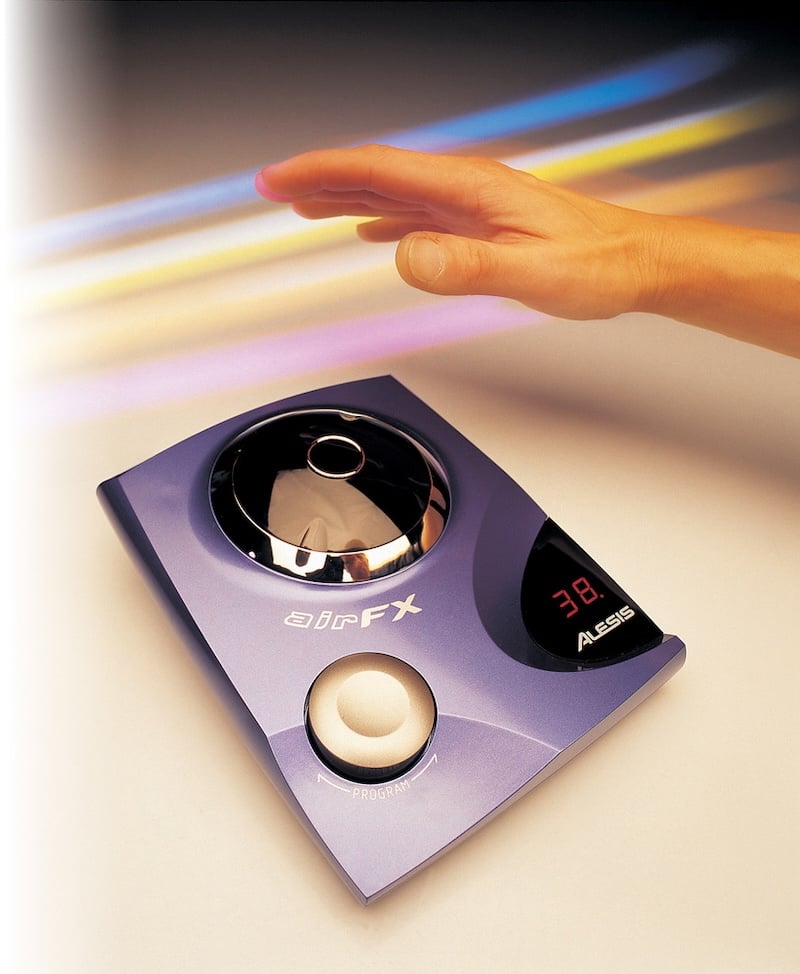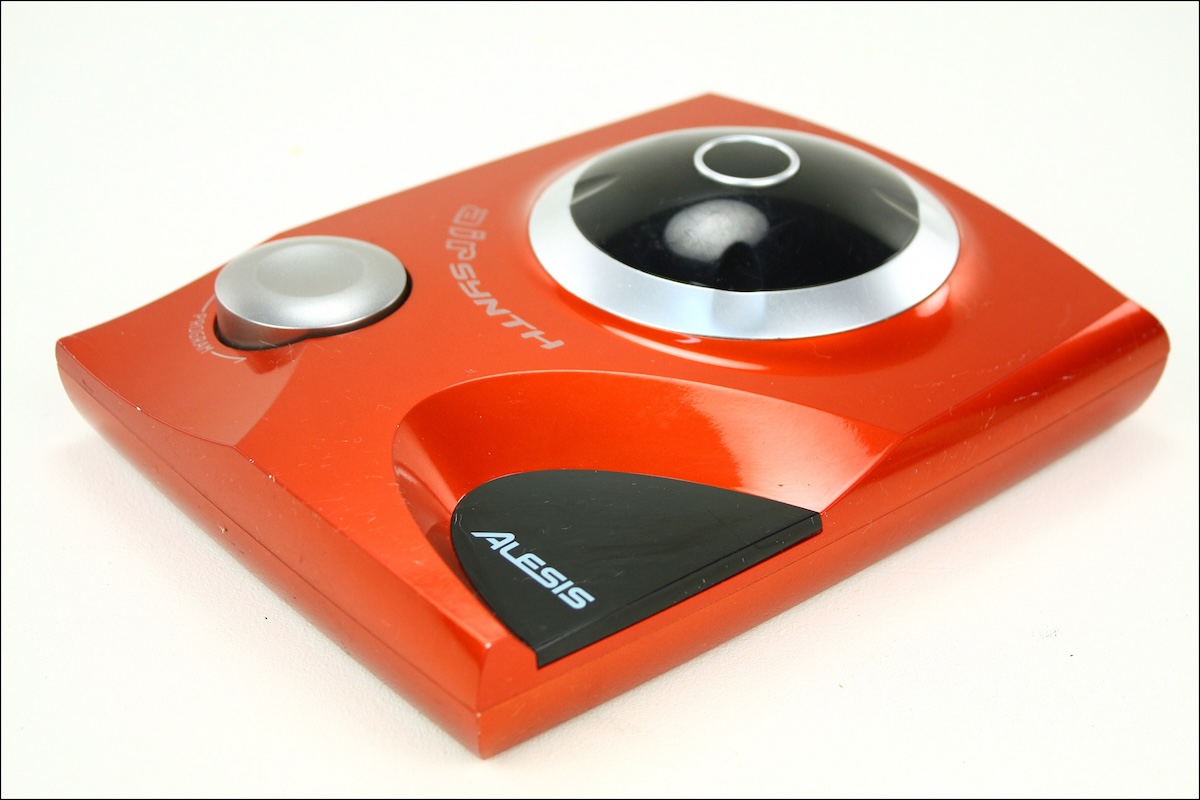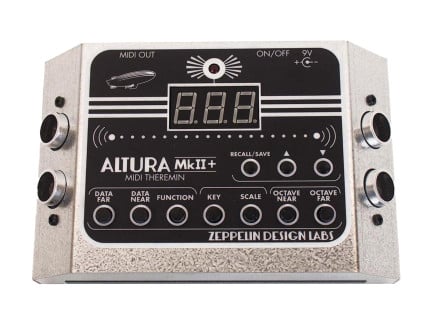Ah, the keyboard. Popularly seen as the pinnacle of human/instrument interaction. But it's not for everyone. Dr Robert Moog began his synthesizer journey with the proximity-based Theremin that you controlled via the placement of hands and fingers in an electromagnetic field around it. The Moog Synthesizer originally had joysticks and ribbon controllers long before it got adapted for a keyboard. Many other modular synthesizer systems eschew the keyboard for alternative methods of control. So, while the piano keyboard is familiar and comforting when faced with a baffling machine of synthesis, it should certainly not be seen as the only approach.
Similarly in terms of control, knobs and sliders appear to be the most efficient way to alter parameters. However, they are not always the most expressive or dynamic. Turning knobs can feel like you are instructing a machine rather than playing an instrument and some of us would really like to feel more involved in the music making.
So, we find that the history of electronic instruments has all sorts of diversions into alternative ways of interacting with the machines that go beyond black and white keys and regular controls. Sometimes these require the practiced nuance of an accomplished musician, like with the Theremin, mimicking the virtuosity of the violinist. But more often this technology offers a much more intuitive, fun and experimental way of interacting with music. The D-Beam from Roland, which appeared on the MC-505 Groovebox in 1998 is a great example of how waving your hand across an infrared controller without elegance or talent can generate interesting modulations, filter sweeps and effects. Another example is the XY touchpad that combines a couple of parameters into a pressure-sensitive pad that can be intuitively controlled with your fingers. Korg used these pads on many synths before coming up with the riot-in-an-effects-box known as the Kaoss Pad that offered a performative way into effects processing.
Firmly in the fun, although not altogether talentless, camp we have the Alesis Air FX and Air Synth. These strange and futuristic-looking boxes were released in 2001 and 2003 respectively and disregarded any semblance of normality or traditional ways of interaction—it's all down to the dark, all-seeing eye of the infra-red sensing array.
Alesis AirFX
Let's start with the AirFX because that at least makes some kind of sense. The Air FX was a pretty cool attempt at doing something different in the new millennium, and it could very well have come straight out of a Space Odyssey. It was designed to be interesting to DJs as well as studios and performers, and mixed a pro-level 24bit effects engine with less than professional phono inputs and outputs. It was the sort of thing you could drop between your decks and amplifier and wave some variation into your set without having to learn the complexities on regular effects processors or deal with the small controls.
All the action revolved around the remarkable perspex dome that housed an infrared projector and an array of sensors. As the light bounced off your hand the sensors could determine the motion in three dimensions. It could handle the side-to-side X axis, the forward and back Y axis and the in and out Z axis. The motion was then translated to control three effect parameters. The results are often hilarious but also superbly entertaining and expressive when used in live performance.
The Air FX has 50 effects programs which covers filters, modulation, synth-style effects and a whole load of crowd-pleasing special effects. You could throw on vinyl degradation, make things bubble, push pitches around and slow the music down to a griding halt. You could pitch it, pan it, strobe it and send it off into an hallucinogenic fazed flange all with a triumphant wave of your hand. The filters were perfect for building tension in club tracks and the visual physical interaction would only increase the effect on the crowd.
All of the effects were designed for dynamic interaction and so whatever you dialled in was going to be fun and do something interesting to the music passing through. There was nothing subtle about it; you just had to go for it.
If you found something you liked, you could "freeze" the effect so you can move your hands away and still have the Air FX in action. Particularly useful for resting your arms from long sessions of waving or freezing the wet/dry mix all the way dry to effectively bypass it.
Disappointingly there was no MIDI so you couldn't control other gear or record your movements into a sequencer. It also meant there was no sync, leaving your arms in charge of the rhythm. But it did its thing brilliantly and was completely at home within its own context.
Alesis AirSynth
Alesis briefly went bust between the release of the Air FX and Air Synth which is why the latter didn't arrive until 2003. It was orange rather than blue but otherwise was the same box, same controls, same infrared sensing array and the same sense of hilarity. But this time it was going to make sounds rather than affect them. The closest comparison would be to that of the Theremin in basic function but without any of the class or nuance required to make it sound nice.
There are a number of Theremin-type sounds inside with formant filters and the far flung potential of elegance for something approaching a refined performance. But the Air Synth is not at that sort of party. It's brash and bonkers with sequenced beats, throbs, percussive stabs, experimental modulations and complex synth pads. Pitch quantisation helps with trying to find a tune with the placement of your hand but you get the impression that the strength is in dramatic events and intentional percussion. You would sort of throw your hand at it to trigger and then move it to affect the sound and that meant it was fairly haphazard rather than precise. But you've got to imagine it in the context of live performance or a chaotic DJ set which is where they really start to make sense.
In comparison to the D-Beam, the Alesis Air had three dimensions of control rather than the D-Beams singular distance measuring. Maybe it's more akin to the XY Touchpad which can, in some cases, offer pressure for the Z-axis along with the X and Y axis of position. Touchpads are usually employed alongside a traditional keyboard and so are generally used to apply a little bit of restrained expression whereas the Air is all in whether you like it or not.
As with the Air FX the Air Synth also doesn't have MIDI which does restrict its reach and usefulness as a more general controller.
AirFX + AirSynth in Retrospect
I think on the whole the Alesis boxes win in terms of fun, interaction and their ability to add accent and events to your performance. So many more recent attempts at providing spatial interaction, like with VR, gesture rings, gloves and energy fields tend to lean towards seriousness of the Theremin and all the precision and arm fatigue that entails. While the Air FX and Air Synth are toy-like and easily dismissed, they are a lot of fun, instant and can make any performance better. Isn't it about time for a revival?

The popularity of Modular synthesis has got us thinking again about how we interact with the machine. The Bela Gliss Touch Controller is a good example of some very impressive and versatile tech behind what looks like a very old-school capacitive touch surface. There are plenty of touchpad-style Eurorack modules that offer XY control and joysticks are always an interesting way of interacting differently to moving single knobs. For three-dimensional interaction check out the alarming String Thing from Nervous Squirrel which is ring tied to a 3 meter recoiling string that generates voltage in response to the rings position.
In terms of waving at your machine, light-dependent resistors are common on a number of modules but there are some infrared options if you dig around. Music Thing Modular has the Move Motion Sensor which generates voltage in response to movement. The Wave Ring from Genki Instruments lets you transmit MIDI control with the movement of a ring on your finger. This can also be transmitted to a Eurorack module for CV generation.
However, all these options (with the exception of the mad String Thing) miss the joyful exploration of sound and interaction that poured out of the weird Alesis boxes. I would love to see that disturbing, perspex dome staring out of my modular and wave its happy voltages through my rack.

















